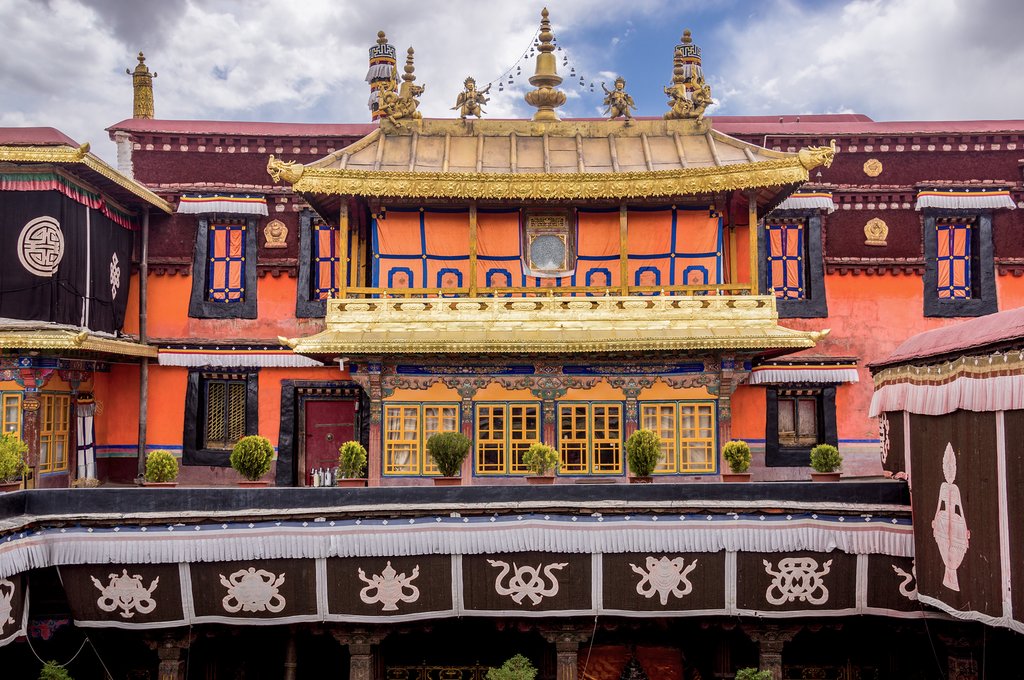
How to Get from Beijing to Lhasa

It takes a bit of pre-planning to make the 2,175-mile (3,500 km) trip from Beijing to Lhasa (nicknamed the "Roof of the World"). Travelers can go by a relatively quick plane ride—4.5 hours nonstop—or a lengthy, and very scenic 40+ hour train journey. While the flight may seem like the better option by duration alone, taking the train is actually preferable when considering the leap in altitude: Lhasa sits at over 11,000 feet, and the gradual train ascent is very helpful with acclimatization.
Travelers headed to Tibet must use a Chinese travel agency to apply for a Tibet Entry Permit; independent travel to Tibet is not allowed, so travelers must be part of an organized group. Tibet Entry Permits are not issued for travel during Tibetan New Year (late February or early March), and Tibet is often closed to visitors January to March, but entry may be halted at anytime.
The Tibet Entry Permit is in addition to a Chinese Tourist Visa; travelers must have a Chinese Tourist Visa first before a travel agency can apply on their behalf for the Tibet Entry Permit. The Tibet Entry Permit is for travel within Lhasa only; travelers wanting to explore other parts of Tibet need to have their travel agency apply for additional permits.
You have plenty of itinerary options, from a 4-Day Highlights of Lhasa Tour to the more comprehensive 7-Day Discover Tibet's Cities Tour, 9-Day Ultimate Tibetan Experience, and 11-Day Tibet Train Journey & Everest Base Camp Tour.
By Plane
Duration: 4 hours and 30 minutes
There are a couple daily flights, including one nonstop flight from Beijing Capital International Airport, which is 18 miles (30 km) northeast of Tian'anmen Square, and the new starfish-shaped Beijing Daxing International Airport—set to be the world's largest airport when it officially opens at the end of September—which is 30 miles (50 km) south of Tian'anmen Square, to Lhasa Gonggar Airport.
While flying to Tibet is the quickest travel option, it gives travelers virtually no time to acclimate to Tibet's high altitude. Most travelers opt to take the train from Beijing to Lhasa and then fly back from Lhasa to the Chinese capital or onward to other cities.
By Train
Duration: 40 hours and 53 minutes
The two-day journey on the Qinghai-Tibet Railway, the world's highest railway, departs from Beijing West Railway Station, and travels 2,334 miles (3,757 km) through eight provinces before arriving at Lhasa Railway Station (Officially the Qinghai-Tibet Railway begins in Xining, but the Beijing-Lhasa route runs direct and covers the same path).
Options include soft sleeper (there are four beds in each cabin) and hard sleeper (there are six beds in each cabin). The train has a dining car serving simple fare and snacks like instant noodles, potato chips, crackers, cookies, bottled soft drinks, beer, and water, and there are hot water dispensers to use for making instant noodles, coffee, and tea.
Taking the train is better than flying, not only because of the incredible scenery, but it can also make it easier for travelers to acclimate to the extreme altitude. When the train ascends Tanggula Pass, the highest point of the journey—and at 16,640 feet (5,072 meters)—the highest point on a railway in the world, oxygen is pumped into the train cars. Passengers can also use the individual oxygen masks in their sleeper compartments.
Along the way, travelers can marvel at the contrasts in landscape: Qarhan Salt Lake, Yuzhu Peak, Kekexili Nature Reserve, Tuotuo He River, Tsonag Lake, and Qiangtang prairie. Travelers concerned about altitude sickness may consider breaking up the journey and spending a night or two in Xining, the capital of Qinghai province, which is 7,464 feet (2,275 meters) above sea level.